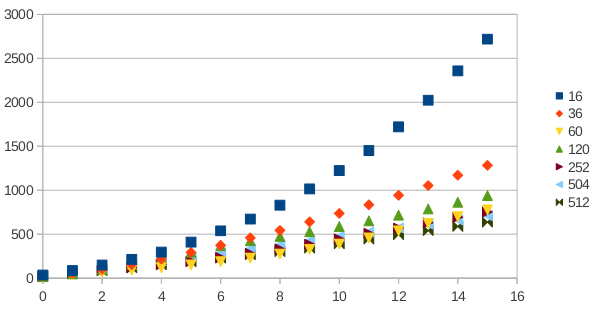GENETATOMICS
From HP-SEE Wiki
(→Resource requirements) |
(→Development Plan) |
||
| Line 42: | Line 42: | ||
== Development Plan == | == Development Plan == | ||
| - | * Concept: ''.'' | + | * Concept: ''The concept has been planned before the M1.'' |
| - | * Start of alpha stage: '' | + | * Start of alpha stage: ''M1-M8'' |
| - | * Start of beta stage: '' | + | * Start of beta stage: ''M9-M10'' |
| - | * Start of testing stage: '' | + | * Start of testing stage: ''M11-M13'' |
| - | * Start of deployment stage: '' | + | * Start of deployment stage: ''M14-M15'' |
| - | * Start of production stage: '' | + | * Start of production stage: ''M16-M24'' |
== Resource requirements == | == Resource requirements == | ||
Revision as of 07:59, 23 March 2012
General Information
- Application's name: Genetic algorithms in atomic collisions
- Application's acronym: GENETATOMICS
- Virtual Research Community: Computational Physics
- Scientific contact: Dragan Jakimovski, dragan.jakimovski@gmail.com
- Technical contact: Jane Jovanovski, janejovanovski@gmail.com
- Developers: Faculty of Natural Science and Mathematics, UKIM, FYROMacedonia
- Web site: http://wiki.hp-see.eu/index.php/GENETATOMICS
Short Description
The computer simulation and modeling of various processes involving highly charged ions in plasma are extremely important in contemporary physics. The knowledge of cross sections of electron capture and ionization processes as well as of corresponding sections for excitation of electron(s) in atoms and ions colliding with impurity ions in reactor plasma is valuable in calculations of other plasma parameters and diagnostics of its characteristics in experimental reactor ITER to be build in France. Of special interest are the details of cross sections for different plasma temperatures. The usage of HPC for this application will increase the performance of the genetic algorithms, allowing processing of more parameters and larger intervals in single run.
Problems Solved
The objective of our work is to calculate these multivariable functions (which arise with Schrodinger equation in general) with different values of parameters and different ranges of variables, which in many cases is computer intensive, and require high amount of CPU time. For now the code has been tested, also on various other systems of equations, prominent in physics, applied mathematics and economics
- Volter-Lotka system,
- Equations with non-analytical solutions, and
- GDP equations from economic theory
For systems for which there is known analytical solution the comparison with the numerically obtained result is excellent.
Scientific and Social Impact
Contribution to IAEA and atomic collisions research community, as well as research groups in quantum physics in general. The availability of robust, thoroughly tested parallel genetic algorithm code for various quantum problems with different effective potentials should be beneficial to all those developers interested in independent check of their own, more specialised codes. Possible scaling of the code to large number of processors (up to, say 100) for solving more complex problems and eventually to huge number of more than 100 thousand, processors with different hardware / software environment may prove itself to have important social impact.
Collaborations
- International Atomic Energy Agency, Vienna
Beneficiaries
- Research groups working in atomic / ion collisions and quantum physics in general, for double-checking their own codes;
- Universities and educational centres with strong program in HP physics computing
Number of users
3
Development Plan
- Concept: The concept has been planned before the M1.
- Start of alpha stage: M1-M8
- Start of beta stage: M9-M10
- Start of testing stage: M11-M13
- Start of deployment stage: M14-M15
- Start of production stage: M16-M24
Resource requirements
- Application tools and libraries: none
- Number of cores required: 128 - 2048
- Minimum RAM/core required: 0.5GB
- Storage space during a single run: 10MB
- Long-term data storage: 5GB
- Total core hours required: 1 000 000
Technical Features and HP-SEE Implementation
- Primary programming language: FORTRAN
- Parallel programming paradigm: SMP and MPI
- Main parallel code: In-house development
- Pre/post processing code: In-house development
- Application tools and libraries: .
Usage Example
The application is currently being used by hardcoding the new problems into the FORTRAN source. The user then recompiles the source and starts it using desired number of processes using.
Infrastructure usage
- Home system: HPCG (Bulgaria)
- Applied for access on: 09.2010
- Access granted on: 09.2010
- Achieved scalability: 16 cores
- Home system: HPGCC.FINKI (Macedonia)
- Applied for access on: .
- Access granted on: .
- Achieved scalability: 60 cores for the current data sets (tested until 504 cores). The application was tested direclty, before the cluster is operational for testing purposes
- Accessed production systems:
- .
- Applied for access on: .
- Access granted on: .
- Achieved scalability: .
- Porting activities: .
- Scalability studies: .
Running on several HP-SEE Centers
- Benchmarking activities and results: The application was successfuly tested for its scalability on HPCG cluster in Bulgaria. Due to long queue waiting times, the problem was not tested for scalability beyond 16 cores. On the HPGCC cluster in Macedonia, the application was used to initially test the system and achieved a scalability of 120 cores. The tests were executed over a medium data set, and we believe that it will scale even more on larger data sets. The results of the scalability measuremets are shown in the following figures:
- Other issues: .
Achieved Results
Publications
- J Jovanovski, B Jakimovski and D Jakimovski, Parallel Genetic Algorithms for Finding Solution of System of Ordinary Differential Equations, publication submitted to ICT Innovations 2011 conference
Foreseen Activities
- Implementation of a hybrid version using an OpenMP
- Implementation of a more configurable application that will accept the problem functions using a configuration file without influencing performance
- Implementation, testing and production of the code for two-heavy-centers-one-electron system
